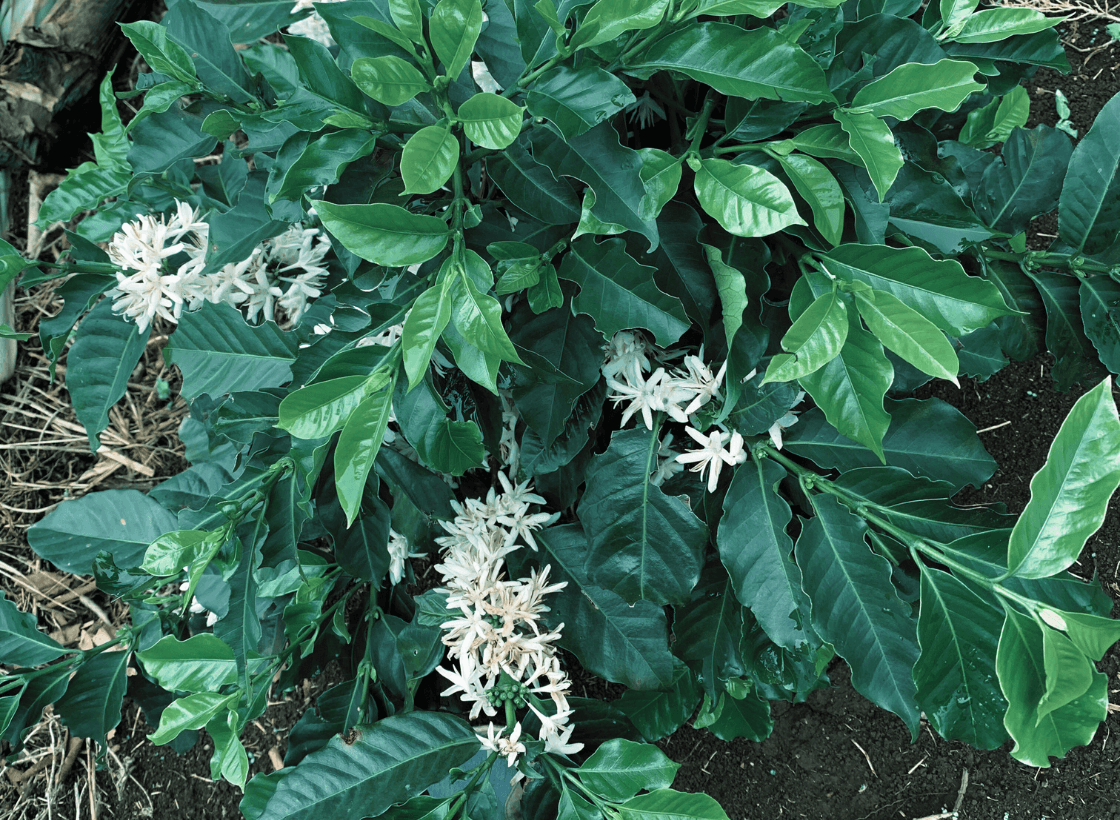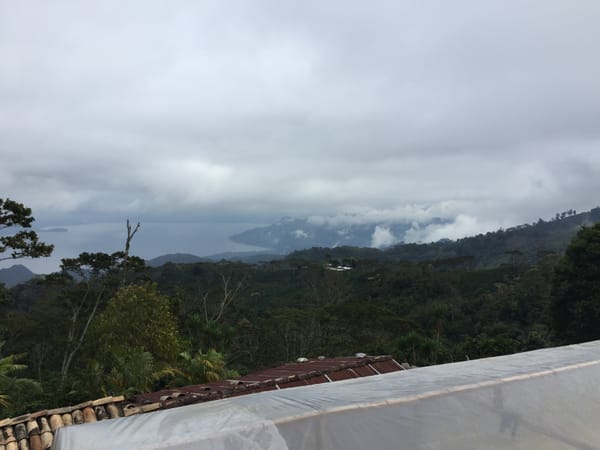February 2024 Subscription with Ildefonso Cordoba and Muchagara

It's funny that we tend to expect immutability out of coffee, the most mutable thing around. We're obsessed with replicating a taste experience. There are countless permutations, decisions (often amounting to a spit second) while roasting that inevitably impact the end result. Maddeningly, many of you know that extends to brewing (we all just have to roll with it). Countless variables (some we can control and others, not so much) will always be there, acting like a labyrinth we all have to go through. The deal we make when we decide to go through it is the possibility of a result that delights us, even though it may be different than what we expect.
What are we up to this month? Wading through a few of these aforementioned labyrinths of course :) Nate and I are dialling in more fresh arrivals from southern Huila (the first of which is in your box this month). We're also beginning to cup possibilities from the South and West of Ethiopia for this 2024 harvest, and all the while, taking a sec to celebrate the lunar new year (because of course).
Mutability extends into how we name things in coffee too. Anytime the coffee-verse declares something unchangeable, it's only a matter of time before the universe dares us to rethink that rigid resolve.
In coffee linguistics once called 'variety' now is 'varietal' (as an elder millennial, I'm still struggling with this one).
In visual interiors, once having an insert-descriptive-here aesthetic, is now, simply 'aesthetic'
Perhaps not a linguistic example, but Pink bourbon' is another thing - not a bourbon after all, it appears.
In the first two examples, the collective is reframing the subject, in the last one, the subject is demanding to be reframed. This month we dig into Pink bourbon (or 'bourbon' we'll see how the coffee collective handles how we name this variety going forward) and the delight of being totally wrong about something totally delicious. Paired with another instalment from our Juicebox series (Muchagara), this box is is pure punchy hot fruit. Things we want for Feb, no doubt.
Enjoy both and happy lunar new year!
-Laura & Nate
A pink bourbon deep dive.
Last year we hadn't put Ildefonso Cordoba's coffee in the sub due to how many bags we sourced, timeline of other coffees slated for the sub etc, but we always had the intention to put Ildefonso's coffee in subscriptions next harvest. So here we are.
The origin story of how Pink Bourbon came to be is a sort of sister story to Santa Bárbara Honduras' Parainema. Both involve a variety that was shared peer-to-peer throughout a community. Both were beloved and cultivated without a clear understanding of what the variety was at first (in the case of Parainema, there was a typo on the bag of seeds so folks misread the name thinking it was Pacamara). Both grew incredibly well in their respective climates and both have uniquely gorgeous cup profiles. The lore is strengthened too by the element of surprise and delight that what folks thought they were farming and tasting was not the full story - and crucially, these stories and revealed information only adds to the collective appreciation of how we get to access these treats.
Pink 'Bourbon'
Just as sungold cherry tomatoes (Nate and I look forward to vining in front of our apartment window in East Vancouver this summer) are a golden hue when ripe, coffee, delightfully, shares in these idiosyncrasies. Some varieties ripen to a sunny orange, others a blush pink in addition to the Pinot or dark cherry standard. Pink Bourbon ripens to a kind of rose quartz/ coral, and it's become a downright obsession in Central and South Huila, where Ildefonso is piling on the pandemonium. His interest is justified - Between the ease of growing, the relative heartiness compared with other strains, and the flavour, Pink Bourbon has a good ROI (for those lucky to be in the right climate to grow it). This mysterious variety was found growing in Colombia, potentially Palestina, where the Colombian Coffee Growers Federation ran an experimental farm in the 1950s and 60’s planted with 500 varieties. It's suspected that this is where Pink 'Bourbon' first turned up (though ultimately its origin story is unclear), and has been turning up randomly in other farms in the area over the years. As of quite recently, thanks to a curious importer in the US, we now know definitively that this variety is genetically related to Landraces from Ethiopia, and not the Bourbon mutation everyone suspected. Pink 'Bourbon' has only grown in popularity with farmers and buyers alike ever since. I'd say though, that in addition to the tastiness of the variety itself, the major factor of why it tastes the way it does comes down to how the resulting lots are fermented.
I sometimes wonder about the meeting I had with JARC ten years ago about how they expressed interest in working with Colombia as a sort of peer-to-peer learning opportunity (Ethiopia are otherwise highly and justifiably reticent (https://enjoylunacoffee.com/seed-sovereignty-coffee-and-a-real-life-dark-crystal-narrative/) to work with others). Looking back to the 1950s-60s, there was a huge push by the FNC to come up with more hearty, disease resistant varieties (Variedad Colombia and Castillo both came out of these efforts) - Maybe an Ethiopian Landrace of some kind made its way out of the lab somehow and into the farming community in Huila from those FNC trials in the 50s. Maybe it will happen again. Perhaps it was another instance of a variety being gifted to a producer in a quiet sort of way, only to reach fever pitch years down the line. We may never know. It's fun to speculate.
So, how do we know it's not Bourbon?
Back in Late September of 2023, an importer based in the USA posted a blog detailing their efforts to get Pink 'bourbon' genetically mapped by two different labs, once in 2017, and again in 2023. The results were so clear that it wasn't Bourbon that it sent shockwaves through the industry with industry digital publication Sprudge covering the results as well.
“All five are containing Pink Bourbon, which has nothing to do with Bourbon, as it is an Ethiopian landrace. People would say it is a mutation of Bourbon; it could not be further away from truth.”
- Christophe from RD2 Vision as told to Cafe Imports based on the samples they sent to this lab.
Should we call it pink bourbon?
Not sure, this will be up to the collective and how our amorphous blob of jargon wants to express itself - but I know once I get a slice of time, we'll need to update the Audio Zine Ildefonso Cordoba episode to reflect this new information, which I feel makes this variety even more special.
Moral of the story, always stay open to new information. Nothing is truly immutable, be it our perspective or the subject itself. Staying stagnant or dogmatic and closed isn't helpful and isn't fun. Staying open, experimenting, like the specialty coffee community in southern Huila, continually open to different processing techniques and varieties - Those folks are crushing it, and we’ll continue to define how they’re crushing it in other ways next month.
Ildefonso Cordoba Pink Bourbon
- Producer - Ildefonso Cordoba
- Cultivar - pink bourbon (Ethiopian landrace)
- Where was it grown - Finca La Esperanza, Vereda Pensil, Huila, Colombia
- Tastes Like - pink jam, guava, watermelon & orange
Incredibly stoked to release this late 2023 harvest of Pink Bourbon from Ildefonso Cordoba from Bruselas in Huila, Colombia. Tasting Like pink jam, guava, and sticky sweet. Part of the magically talented Guacharos producer group (those of you who had the Guacharos producer blend we had last month can attest!) who often congregate in nearby Pitalito, Ildefonso is a linchpin of sorts. Acting as the resident seed guy, he's constantly sharing his knowledge about different cultivars and sharing seed stock with the neighbourhood and other Guacharos members.
Ildefonso prepared this lot in the same way as most other washed lots in the region: It’s been fermented in cherry in sealed bags for 60-70 hours, then depulped and fermented under water for 48 hours before drying the resulting parchment on raised beds in a slow and steady way. Both that in-cherry fermentation step and the additional underwater step allows for a low to no oxygen environment, lending a lot of those tropical and often banana-like flavours ever present in Pink Bourbon.
This delight of a Pink Bourbon is courtesy of our sweet friends at Shared Source, who've been buying from the Guacharos group for the past eight years (and no doubt beyond). They've built up such a good rapport with these folks that it's a no-brainer to work with them for treats like this one.
Shared Source says this of Ildefonso:
"He’s also known as the clown of the Los Guácharos group – he’s funny, sweet, and, as an active, involved member, he lifts the spirit of the group significantly. Though he comes from a coffee-producing family, he started his farm from scratch, and has managed to bring it to the point where it’s producing great quality coffee 12 years into his endeavour."
Muchagara
Blackberry, currant black tea
A field blend of SL28, SL34, Ruiru11, & Batian varieties. Picked by smallholders and delivered to Muchagara washing station in Kirinyaga, Kenya to be processed. Fermented in the traditional double washed method and dried on raised beds. Roasted for filter. Punchy & crisp.
- Kirinyaga
- Baragwi FCS
- BATIAN, SL- 34, RUIRI 11, SL-28
- Double washed
- 1700 - 1800 MASL
- 16 - 24hrs under water
- 16 - 18hrs Soak
- Dried on raised beds for around 3 weeks
Muchagara opened in 1959 and is named after a village in the Kirinyaga county. This is the oldest processing factory in Kirinyaga. The area around this factory is known for its ideal growing conditions, making the location of this centre convenient for smallholders around this area. It is part of Baragwi farmers cooperative society which currently has around 1700 member farmers. During harvest, smallholders in the area deliver ripe cherries to the factory for sorting and processing. An Agaarde disc pulping machine removes the skin and pulp of the cherries before they undergo a period of grading to ensure only the highest quality cherries get passed on. After a period of fermentation for 16-24 hours, the coffees are washed with clean water and soaked for another 16-18 hours to create that distinct crisp acidity that Kirinyaga coffees are known for. Lastly, the coffee beans are covered and dried on raised beds under the sun for 21 days. The resulting coffee is juicy, sweet, and sparkly with flavours like blackberry, black currant with black tea adding some complexity to what's a quite punchy cup.
Luna is powered by Laura & Nate, two industry nerds from Vancouver, Canada. What you just read comes as a printed colour zine each month, alongside two coffees specifically sourced for subscribers. Join us next time!





